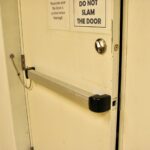When this story was posted on Facebook yesterday, several people attempted to address the code issues associated with the teenager’s invention. A commenter posted a link to one of my articles, and another commenter called my article “a fallacy”!
From CBS Minnesota:
The truth is, the type of device shown in this news story is not compliant with the model building codes, model fire codes, or national accessibility standards. And with the device sitting “right next to the door or at least within arm’s reach” (as stated in the news report), what is to prevent an unauthorized person from putting it in place to secure the classroom? I wonder how easy it is to remove it for evacuation once an intruder has given the door a few good kicks. This is the type of performance criteria that would be tested by the standards used for locks, panic devices, and other door hardware, but these products are not tested to those standards – or any standards actually.
The news report seems to indicate that the schools mentioned are in Minnesota, but after speaking with someone from the Minnesota State Fire Marshal’s office, it appears that the schools are actually in Wisconsin. That’s unfortunate, because the Minnesota SFM has a very clear policy on school security – available here. The summary at the end of their information sheet states, “Although at first glance the use of door security and barricade devices may appear to offer a practical solution to lockdown security, their use creates additional and unacceptable hazards–hazards that have successfully been addressed by fire and building code language born of past tragedies. Current codes allow fire-safety, life-safety, and security to be accomplished in balance without one negatively affecting the other.”
I was unable to find a written policy from the Wisconsin State Fire Marshal. Regardless, the model codes have been discussed and modified, with changes incorporated into the 2018 editions. The statistics on school crime show that the vast majority of school-related shootings are perpetrated by students (according to the CDC and the FBI). Guidelines from the National Association of State Fire Marshals (NASFM) and the Partner Alliance for Safe Schools (PASS) require code-compliant hardware to be used on classroom doors. The use of non-code-compliant security devices creates potential liability for schools or other facilities using them (there’s more about this on LockDontBlock.org). What’s left to clarify??
You need to login or register to bookmark/favorite this content.





I like how they had the latchbolt held back with the rubber band.
What’s also a bit irksome is the “Airborne” effect – first used widespread by the Airborne Nutritional “supplement” faux-cold-remedy “Invented by a Teacher!” (I like my medicines to be invented by, um, doctors and scientists, personally.) The invented-by-a-teenager, discovered-by-a-puppy, manufactured-by-toddlers marketing makes these stupid things too irresistibly man-bites-dog to local news shows.
I know – very frustrating.
– Lori
These people need to leave the “inventing” to the experts in the industry who actually read and understand codes. I fear it is going to take one of these “safety” devices being used to perpetrate a crime for people to open their eyes.
What was the purpose of the green rubber band around the lever?
It seems to me we will need a tragedy to show that these secondary non code compliant devices are worse than the perceived threat they are trying to mitigate.
I agree – I just hate to wait for a tragedy to illustrate something that is so clearly a hazard. AND – there are likely to be problems we don’t hear about. The details of the majority of crimes that occur in schools are not widely reported, so if someone hits someone over the head with this invention, we probably won’t know.
– Lori
https://dsps.wi.gov/Documents/Programs/Maps/CommercialBuildings.pdf
In Wisconsin the State Fire Marshal is in the Department of Justice, and as such has nothing to do with commercial building codes. These are handled under the Department of Safety and Professional Services. The link is to the State contacts for their respective inspection areas. Smaller communities may not have a local Fire Inspector. I’m sure Safety and buildings would appreciate your comments.
M W Schroeder Fire Code Enforcement Officer Retired
Thanks Michael!
– Lori
Granddad had a phrase for these folk:
Educated idiots!
How about taking the rubber band off of the latchbolt and locking the door, or is that too simple for these brainiacs?
Just reinforces the old adage:
“you can’t fix stupid!”
In all practicality it is faster to turn a key in the inside cylinder of a classroom security lock than all of the mechanical garbage these “inventors” dream up. Why don’t they understand that?
At what point do we provide access control and credentials to each and every normal occupant of a school? Washington State University is doing that now. K-12 needs to get in the groove. Corporate America does it. Time for schools to get serious and put the window dressing away.
I live in Minnesota and saw the teaser for this on our local CBS station. What I didn’t realize is that this school is one of my clients. I redid the Masterkey system in that school a few years ago.
Our job of educating does not end.
You’re right -it will never end. Even some iDH readers who have retired still regularly educate and inform people about life-safety concerns.
– Lori
Lori,
The town listed above is 10 miles from the town that I live in. I have reached out to my school district superintendent and implored him “not” to buy any of this devices as they are a life safety issue. I also informed him to contact me to discuss this product (might have to fly out up here to educate him) As of today (Friday, I emailed him on Wednesday) I have not heard back from him.
With regards to the student though, he does have some ingenuity and drive, and it looks like he’s a decent welder. Might have to offer him a job at our hollow metal plant 🙂
Thanks for sharing this information with the superintendent!
– Lori